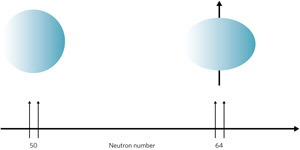Home > Press > Out-of-shape nuclei: Adding neutrons to synthetic atoms can drastically alter the shape of their nuclei and affect their stability
 |
| Figure 1: Adding neutrons to the nucleus of a zirconium atom changes its shape from spherical to oblate.
Hiroyoshi Sakurai |
Abstract:
To probe the evolution of atomic nuclei with different shape —a factor which affects atomic stability—a large team of international researchers has added neutrons to zirconium atoms and revealed the possibility of very unusual shapes1. "The shape of a nucleus reflects the symmetry of its quantum state," explains team member Hiroyoshi Sakurai from the RIKEN Nishina Center for Accelerator-Based Science in Wako. This result helps us to understand how many neutrons are needed for the most stable nuclei.
Out-of-shape nuclei: Adding neutrons to synthetic atoms can drastically alter the shape of their nuclei and affect their stability
Japan | Posted on August 26th, 2011Most atoms can exist in one of several alternative forms called isotopes, depending on the number of neutrons in their core. Naturally occurring, stable, atoms tend to have between 1 and 1.5 neutrons per proton. However, synthetically generated atoms with higher neutron-proton ratios can reveal much about changes within an atomic nucleus.
The protons and neutrons in a nucleus usually form arrangements of concentric spherical shells. In some cases, however, the outermost particles exist further from the center than normal. This can lead to nuclei that are wider than they are long. Just as atoms with a specific number of protons can exist as different isotopes, atoms with a specific number of protons and neutrons can exist as different nuclear isomers—nuclei with different shapes. "By measuring the shape of nuclei, we are probing the internal symmetry in the nucleus—the so-called shell structure," explains Sakurai.
At the Radioactive Isotope Beam Factory in Japan, operated jointly by RIKEN and The University of Tokyo, the researchers experimented with zirconium atoms that have 40 protons and, in their stable form, between 50 and 52 neutrons. They created zirconium atoms with as many as 68 neutrons through collisions between uranium and beryllium atoms. After filtering isotopes from the remnants of the collision, they measured the rate of decay of beta and gamma radiation emitted by the quickly decaying, unstable synthetic atoms. The measurements showed that these nuclei changed shape from spherical to oblate (Fig. 1).
The degree of deformation of the zirconium nuclei increased as Sakurai and colleagues added more neutrons, but this trend stopped when they reached 64 neutrons. This result raises the intriguing prospect of a tetrahedral-shaped isomer of zirconium-108—an isotope with 68 neutrons—which has been predicted previously by other researchers. However, further work is needed to verify this.
"We next hope to gain further insight into the evolution of nuclear isomers by extending our study to strontium atoms," Sakurai says.
The corresponding author for this highlight is based at the Radioactive Isotope Physics Laboratory, RIKEN Nishina Center for Accelerator-Based Science
####
About Riken Research
RIKEN is one of Japan’s largest research organizations, with more than 3,000 scientists involved in leading research in centers and institutes across Japan and around the world.
For more information, please click here
Copyright © Riken Research
If you have a comment, please Contact us.Issuers of news releases, not 7th Wave, Inc. or Nanotechnology Now, are solely responsible for the accuracy of the content.
| Related News Press |
News and information
![]() Researchers develop molecular qubits that communicate at telecom frequencies October 3rd, 2025
Researchers develop molecular qubits that communicate at telecom frequencies October 3rd, 2025
![]() Next-generation quantum communication October 3rd, 2025
Next-generation quantum communication October 3rd, 2025
![]() "Nanoreactor" cage uses visible light for catalytic and ultra-selective cross-cycloadditions October 3rd, 2025
"Nanoreactor" cage uses visible light for catalytic and ultra-selective cross-cycloadditions October 3rd, 2025
![]() Researchers tackle the memory bottleneck stalling quantum computing October 3rd, 2025
Researchers tackle the memory bottleneck stalling quantum computing October 3rd, 2025
Laboratories
![]() Researchers develop molecular qubits that communicate at telecom frequencies October 3rd, 2025
Researchers develop molecular qubits that communicate at telecom frequencies October 3rd, 2025
Physics
![]() Quantum computers simulate fundamental physics: shedding light on the building blocks of nature June 6th, 2025
Quantum computers simulate fundamental physics: shedding light on the building blocks of nature June 6th, 2025
![]() A 1960s idea inspires NBI researchers to study hitherto inaccessible quantum states June 6th, 2025
A 1960s idea inspires NBI researchers to study hitherto inaccessible quantum states June 6th, 2025
![]() Magnetism in new exotic material opens the way for robust quantum computers June 4th, 2025
Magnetism in new exotic material opens the way for robust quantum computers June 4th, 2025
Discoveries
![]() Researchers develop molecular qubits that communicate at telecom frequencies October 3rd, 2025
Researchers develop molecular qubits that communicate at telecom frequencies October 3rd, 2025
![]() Next-generation quantum communication October 3rd, 2025
Next-generation quantum communication October 3rd, 2025
![]() "Nanoreactor" cage uses visible light for catalytic and ultra-selective cross-cycloadditions October 3rd, 2025
"Nanoreactor" cage uses visible light for catalytic and ultra-selective cross-cycloadditions October 3rd, 2025
Announcements
![]() Rice membrane extracts lithium from brines with greater speed, less waste October 3rd, 2025
Rice membrane extracts lithium from brines with greater speed, less waste October 3rd, 2025
![]() Researchers develop molecular qubits that communicate at telecom frequencies October 3rd, 2025
Researchers develop molecular qubits that communicate at telecom frequencies October 3rd, 2025
![]() Next-generation quantum communication October 3rd, 2025
Next-generation quantum communication October 3rd, 2025
![]() "Nanoreactor" cage uses visible light for catalytic and ultra-selective cross-cycloadditions October 3rd, 2025
"Nanoreactor" cage uses visible light for catalytic and ultra-selective cross-cycloadditions October 3rd, 2025
|
|
||
|
|
||
| The latest news from around the world, FREE | ||
|
|
||
|
|
||
| Premium Products | ||
|
|
||
|
Only the news you want to read!
Learn More |
||
|
|
||
|
Full-service, expert consulting
Learn More |
||
|
|
||








